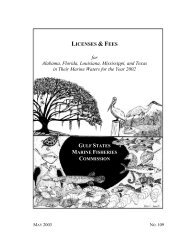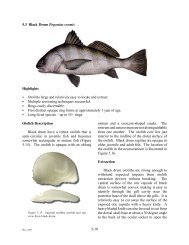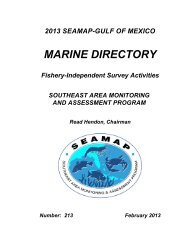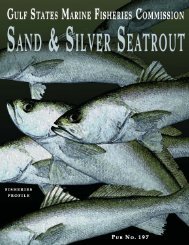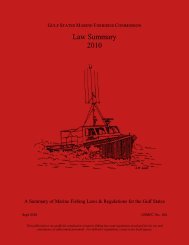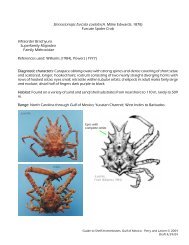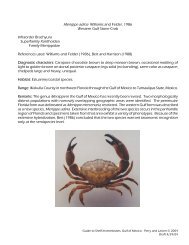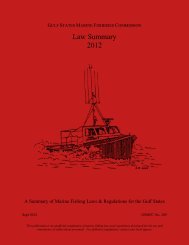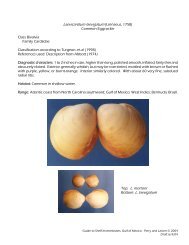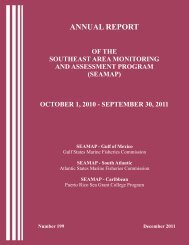Guidelines for Marine Artificial Reef Materials, Second Edition
Guidelines for Marine Artificial Reef Materials, Second Edition
Guidelines for Marine Artificial Reef Materials, Second Edition
Create successful ePaper yourself
Turn your PDF publications into a flip-book with our unique Google optimized e-Paper software.
will be exposed by any of the demolition activities would need to be removed prior to the<br />
demolition. Category II asbestos-containing material may or may not be left in place.. A case-bycase<br />
determination would need to be made <strong>for</strong> these materials….Where there is a question, EPA<br />
or local delegated agency should use sound judgement concerning the fate of the material in<br />
question.” The current requirements in Florida <strong>for</strong> state and federally funded reef projects is that<br />
an EPA or Florida Department of Environmental Protection (DEP) air quality specialists or a<br />
designated certified consultant with asbestos experience must conduct an asbestos assessment of a<br />
vessel prior to sinking. Federal regulations which deal with asbestos are 40 CFR Part 61.145<br />
Subpart M and the OSHA regulations in 29 CFR Part 1915.<br />
Lead<br />
Concerns about the presence of lead in primer coat paints of steel hulled vessels and metal bridge<br />
spans have been expressed by reef managers in recent years. Both Florida and South Carolina<br />
sought guidance on this issue. In a letter written on August 23, 2000 by Roland E. Ferry, Coastal<br />
Programs and Nonpoint Source Section, EPA Region 4, to J. Wayne Hall Assistant Environmental<br />
Manager, South Carolina Department of Transportation, Mr. Ferry stated, “The agency [EPA] does<br />
not consider the lead in paints used on vessels deployed as artificial reefs a significant environmental<br />
or human health risk…The lead in the paint should leach at low rates due to the low solubility of<br />
lead in seawater and is not expected to cause a significant adverse impact. In addition, the removal<br />
of lead based paints may cause greater potential <strong>for</strong> risk of adverse impact to the environment or<br />
human health than if left in place on the structure.” On May 1, 2001 Florida artificial reef<br />
administrator, Jon Dodrill, contacted Dr. Joseph Sekerke with the Florida Department of Health,<br />
Bureau of Environmental Epidemiology. Dr. Sekerke stated that lead paint in a marine environment<br />
would have no adverse human effects and that there was no human health risk. He confirmed that<br />
lead has low solubility in seawater, and stated that it did not bioaccumulate in fish. While there may<br />
be some effect on invertebrate marine organisms that graze directly on the painted surface, he did<br />
not believe toxic effects would be transferred as a risk to humans. However, this should not<br />
preclude removal of visible concentrations of lead such as lead ballast, shielding and fittings.<br />
Fuel and Oil Products<br />
The definition of oil under the Clean Water Act is “oil of any kind or in any <strong>for</strong>m including, but not<br />
limited to, petroleum, fuel oil, sludge, oil refuse, and oil mixed with wastes other than dredged<br />
spoil” [Clean Water Act, Section 311(a)(1)]. On vessels, it would be possible to encounter one of<br />
more refined petroleum products such as gasoline, kerosene, medium to heavy weight fuel oils,<br />
lubricating oils and greases. Crude unrefined oil, synthetic oils, and used or contaminated oils might<br />
also be found.<br />
Hazardous waste cleaning standards which seemed appropriate in the early days of MARAD ship<br />
sinking may no longer be appropriate based upon current experience. For example EPA in the early<br />
1970s developed ship cleaning criteria <strong>for</strong> liberty ships secured under P.L 92-402. One of these<br />
criteria were: “The presence of cosmoline on the walls of fuel tanks can be adequately mitigated by<br />
filling the tanks with water, and bolting and welding the tank hatches closed. Any tanks that will<br />
be ruptured by the explosive charges used to sink the vessel must be free of cosmoline (Source: EPA<br />
Region 4, Atlanta Georgia).” The Liberty ship Joseph L. Meek, sunk off Escambia County, Florida<br />
in 1976, was found 20 years later to be leaking bunker “C” fuel oil from a small corrosion induced<br />
-19-



